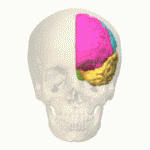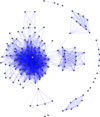Motivation and emotion/Book/2011/Creativity
How can we become more creative?
Overview
[edit | edit source]|
The C Word
 Do you suspect that being more creative would better reflect your values and interests? Or do you know someone that is considered to be a creative person and you long to be like them? Perhaps you are creative but you feel blocked? Perhaps you're worried that were you to openly embrace a creative life or your own creative expression that it would cause you harm. Or cause you torment? Or, indeed, make you crazy? What would you do if you could set those fearful ideas aside? What could you change right now for that to happen? What environmental and personal conditions would support your move to being more creative? Researchers have been trying to isolate, quantify and dissect creativity since the 1950's (Hennessey & Amabile, 2010). In fact, scholarly research on creativity is proliferating and the systematic study of creativity is an active area of scientific investigation (Mumford, 2003). Historically, creativity has been viewed as both one of the most distinctive features of humanity and a mystery (Klausen, 2010). Creativity is one of the key factors in driving civilisation forward, contributing to change and evolution (Hennessey & Amabile, 2010) and is central to human functioning. Yet, creativity is also one of the most elusive human facilities.  Creativity is what Elizabeth Gilbert, in her terrific TED talk on nurturing creativity, calls an irrational process that can, at times, feel almost paranormal. If you were living in ancient Rome or Greece or even in fifteenth-century England, you would consider creativity a mysterious phenomenon not of your own making. In today's world you can take your cue from contemporary science and describe creativity as the production of ideas that are original and useful (Baer, 2010) or as a process of applied imagination (Robinson, 2011). Creativity is of immense practical importance and even though a consensus on the definition has been and is still problematic (Klausen, 2010; Weisberg, 2010) and debates continue to loom large (Hennessey & Amabile, 2010), knowledge about the various aspects of creativity goes a long way to being able to systematically enable and influence creativity. On a practical level, creativity is reactive and to a great extent a person's environment determines when and why a person is creative. 'The impact of environmental factors on motivation and creativity is significant and highly complex' (Hennessey, 2003, p.267). So, what is creativity anyway? Is it merely exceptional skill? Is it a pathological condition? Is it a God-given talent granted to a privileged few? If the persistent conception of the creative person is still that of a moody genius working alone in a garret, then what has feeling good got to do with creativity? Or your social network? Or your motivational orientation? Or your perception of how much control you have over your life? |
Creativity and motivation
[edit | edit source]Creativity is the ability to produce work that is 1) relatively novel, 2) high in quality, and 3) appropriate to the task at hand (Zhu & Zhang, 2011). According to Sternberg and Lubart's Investment Theory of Creativity (1991; 1995), it requires a confluence of six resources: intelligence, knowledge, style of thinking, personality, learning environmental context and motivation (Zhu & Zhang, 2011).
Intrinsic, task-focused motivation is essential for people to focus truly on creative work in an area (Zhu & Zhang, 2011). A breakthrough in research on the forces driving creativity was the identification of two types of motivation, intrinsic and extrinsic. In 1985, preeminent creativity researcher, Teresa Amabile directly tested the hypothesis that intrinsic motivation is conducive to creativity and extrinsic motivation detrimental. This is widely accepted and has been confirmed in many studies since.
Creative drive and arousal levels
[edit | edit source]|
Drive you to distraction
There is considerable anecdotal and empirical evidence that creativity requires a high level of motivation. This high motivation expresses itself as an intense absorption in creative production. Often viewed as a kind of madness, this intensity or drive has been variously identified by twentith century researchers as tenacity of purpose, passion, devotion, driving absorption or persistence (Collins & Amabile, 1999). Creative people have higher baseline levels of arousal and greater response to sensory stimulation (Martindale, 1999). Arousal and stress are two motivationally based responses to stimulating, demanding environments (Reeve, 2009, p.378). Arousal is mostly a function of how stimulating your environment is. Stress is mostly a function of how demanding and controllable your environment is. Creative inspiration occurs in a mental state where attention is defocused, thought is associative, and a large number of mental representations are activated at once . Such a state can arise in three ways: low levels of cortical activation, comparatively more right-hemisphere than left activation, and low levels of frontal-lobe activation. Gregory Feist (1999) reviewed the dispositional characteristics of creative scientists and artists. The outcome of characteristic arousal levels in creative people (Feist, 1999) may exhibit as introversion, independence and subclinical bipolar states. Creative people display high levels of
Colin Martindale (1999) suggests that in high arousal states, attention is so focused on the arousal-inducing situation that innovative associations are less likely to come to awareness. Martindale suggests that only in situations of lower than average arousal can the mind attend to the associative connections necessary for novel ideas. As Martindale puts it in his neural network model of creativity, creative people
Task-focused cognition may be a stimulus control strategy used by creative people to manage arousal and affect (Mumford, 2003). Stress, or high levels of arousal, will inhibit creativity when requisite coping strategies are not available. |
|
The dope on dopamine
 Flaherty (2005) presented a three factor anatomical model of human idea generation and creative drive. Flaherty argues for the importance of connections between the temporal lobes (contains auditory cortex), frontal lobes (involved in motor control and cognition) and limbic system (regulates emotional behaviour, basic motivational urges and memory, as well as physiological functions) and found that frontal lobe deficits may decrease idea generation, in part because of rigid judgments about an idea's worth. Mesolimbic dopamine influences novelty seeking and creative drive. Flaherty's model differs from the previous influential neuroscientific theory of creativity, which postulated that the nondominant hemisphere is specialised for creative activity such as holistic pattern recognition, art and music. However, later evidence suggests that the function of both hemispheres is more important than selectively activating the right hemisphere (Martindale, 1999). Flaherty's model incorporates the involvement of the limbic system in generating drive. Dopamine raises baseline arousal, mediates reward-seeking activity, and triggers the desire to communicate (Flaherty, 2005). The dopamine antagonists used as antipsychotics can suppress not only hallucinations but also creativity (Flaherty, 2005). Flaherty (2005) stresses that creative drive is not identical to skill. For instance, hypergraphia reflects a drive to write, and not necessarily a skill to write. Mesolimbic dopamine plays a role in generating novelty seeking and creative drive. Skill depends on neocortical association areas (Flaherty, 2005). Drive, however, correlates better with successful creative output than does skill, and creative drive can secondarily improve creative skill (Flaherty, 2005). The more you practice writing or drawing, of course, the more proficient you become. In addition, when high motivation increases the number of ideas generated then the number of novel and useful ideas increases proportionately (Simonton, 1999; Flaherty, 2005). |
Motivational orientation and creativity
[edit | edit source]Why is a carrot never enough? or Is that Intrinsic Motivation in your pocket?
Your self-determined creative self
[edit | edit source]- Volition and self-expression
A psychological need is an inherent source of motivation that generates the desire to interact with the environment so as to advance personal growth, social development and psychological well-being (Deci & Ryan, 1985). Deci and Ryan (1985) identified three inherent psychological needs, experiential nutriments we must have if we are to thrive and mature. Their self-determination theory (SDT) identifies the need for autonomy (volition and self-expression), competence (skill and mastery) and relatedness (closeness and connection).
These psychological needs are organismic, that is, SDT assumes that you are an entity that is alive and in active exchange with your environment; this assumes that you are not just reacting to your environment but that you are influencing your environment in a dialectical relationship. Both you and your environment constantly change.
Autonomy fosters creativity in the workplace, and, generally, constraints and pressures at work are detrimental to creativity. Although, under specific circumstances the informational value implicit in performance-contingent rewards has been shown to augment feelings of self-efficacy, intrinsic task interest and qualitative aspects of performance (Hennessey, 2003).
Being provided with choice enhances your sense of autonomy and intrinsic motivation; choice in aspects of how to do a task can enhance creativity and interest (Amabile, 1996). An early study into autonomy and creativity found that when children paint under autonomy-supportive conditions, and are given rationale for rules in informational language, they enjoy the painting more, are intrinsically motivated to paint and produce artwork that is creative, technically good, and of high quality (Reeve, 2009).
A self-determined person is able to resist the controlling situational and intrapersonal forces that can undermine creativity (Sheldon, 1995).
Enhancing creativity
[edit | edit source]|
Be Creative. Now!
Weihua Niu and Dan Liu (2009) studied the effect of two different types of instructions on creativity on Chinese high school students. The first instruction explicitly prompted students to be creative. The second was a heuristic instruction with details on how to be creative; that is, during a story completion task students were told: "To be creative, you could add or take away some characters and scenes when necessary so that the characters and scenes of the story would not limit your creative expression" (p. 95). The results of this study confirmed the hypothesis that changes in the indicative instruction could affect [Chinese] students' creativity. The results were consistent among female and male participants. Take-away message To achieve improvement in creativity, it may not be sufficient to induce creativity by telling someone to be creative. They must also be given 'some basic supervision on how to be creative with elaborate clues (Niu and Liu, 2009). |
Enhancing children's creativity
There are certain techniques and approaches that may be particularly appropriate for children. The following are guidelines for parents and teachers (adapted from Amabile, 1996, p.261):
- Encourage autonomy by avoiding excessive, anxious control of the child's activities
- Respect the child's individuality
- Maintain a loving relationship with the child. Avoid a smothering emotional closeness
- Encourage independence as the child grows
- Emphasise values (guiding principles) for behaviour, rather than rules
- Teach the child the reasoning behind these values.
- Highlight learning achievements in the classroom over grades and competitive awards
- Emphasise the joy of learning, focus on the child's own development of competence and knowledge
- Present a reward as a bonus not a bribe. Use the reward to confirm the child's competence
- Celebrate the child's creativity
Enhancing creativity in all
Raymond Nickerson (1999) suggests that creativity is typically defined in terms of the results of activity. He puts forward the following recommendations for enhancing creativity in others, particularly in children, but anyone can adapt these suggestions to their own creative development:
- Establish purpose and intention.
- Build basic skills.
- Encourage acquisition of domain-specific knowledge.
- Stimulate and reward curiosity and exploration.
- Build motivation, particularly intrinsic motivation
- Encourage confidence and willingness to take risks.
- Focus on mastery and self-competition.
- Promote supportable beliefs about creativity. (The demotivating belief that creativity cannot be increased by effort becomes self-fulfilling.
- Provide opportunities for choice and discovery.
- Develop self-management (metacognitive, i.e. intentional monitoring) skills. Make time for your creative work
- Provide balance. Creativity is not necessarily fostered by a lack of restraint. 'The need for structure, discipline, self-restraint and respect for tradition and convention is as real and important as the need for freedom, spontaneity, innovativeness and risk taking'
- Teach by example. Learn by example.
(Adapted from Nickerson, 1999, p.418)
References
[edit | edit source]Amabile, T. M. (1985). Motivation and creativity: Effects of motivational orientation on creative writers. Journal of Personality and Social Psychology, 48(2), 393-399. doi:10.1037/0022-3514.48.2.393
Amabile, Teresa M. 1996. Creativity in context . Boulder, CO: Westview Press.
Baer, M. (2010). The strength-of-weak-ties perspective on creativity: A comprehensive examination and extension. Journal of Applied Psychology, 95(3), 592.
Collins, M. A., & Amabile, T. M. (1999). Motivation and creativity. In R. J. Sternberg (Ed.), Handbook of creativity (pp. 297–312). Cambridge, England: Cambridge Univ. Press.
Feist, G. J. 1999. The influence of personality on artistic and scientific creativity. In R. Sternberg v (Ed.), Handbook of creativity: 273-296. Cambridge, UK: Cambridge University Press.
Flaherty, A. W. (2005). Frontotemporal and dopaminergic control of idea generation and creative drive. Journal of Comparative Neurology, 493, 147–153
Hennessey, B. A. (2003). The social psychology of creativity. Scandinavian Journal of Educational Research, 47(3), 253.
Hennessey, B. A. and Amabile, T. M. (2010). Creativity. Annual Review of Psychology, 61: 569–598.
Klausen, S. S. H. (2010). The notion of creativity revisited: A philosophical perspective on creativity research. Creativity Research Journal, 22(4), 347-360.
Martindale, C. (1999). Biological Bases of Creativity. Handbook of Creativity. R. J. Sternberg. Cambridge, Cambridge University Press: 137-152
Mumford, M. M. D. (2003). Where have we been, where are we going? taking stock in creativity research. Creativity Research Journal, 15(2-3), 107-120.
Nickerson, R. S. 1999, Enhancing creativity. In R. J. Sternberg (Ed.), Handbook of creativity: 392-430. Cambridge. England: Cambridge University Press.
Niu, W., & Liu, D. (2009). Enhancing creativity: A comparison between effects of an indicative instruction "to be creative" and a more elaborate heuristic instruction on chinese student creativity. Psychology of Aesthetics, Creativity, and the Arts, 3(2), 93-98. doi:10.1037/a0013660
Perry-Smith, J. E. (2006). Social yet creative: The role of social relationships in facilitating individual creativity. Academy of Management Journal, 49(1), 85.
Reeve, J. (2009). Understanding motivation and emotion (5th ed.). Hoboken, NJ: Wiley.
Robinson, K. (2011). Out of our minds: Learning to be creative. Chicester, West Sussex, UK: Wiley.
Runco, M. M. A. (2004). Creativity. Annual Review of Psychology, 55(1), 657-687.
Sheldon, K. M. (1995). Creativity and self-determination in personality. Creativity Research Journal, 8, 61–72.
Simonton, D. K. (2002). Creativity. In Snyder, S. R., & Lopez, S. J. (Eds.),The handbook of positive psychology. Oxford, England: Oxford University Press.
Weisberg, R. R. (2010). The study of creativity: From genius to cognitive science. International Journal of Cultural Policy : CP, 16(3), 235-253.
Zhu, C. & Zhang, L. (2011). Thinking styles and conceptions of creativity among university students. Educational Psychology (Dorchester-on-Thames), 31(3), 361-375.



